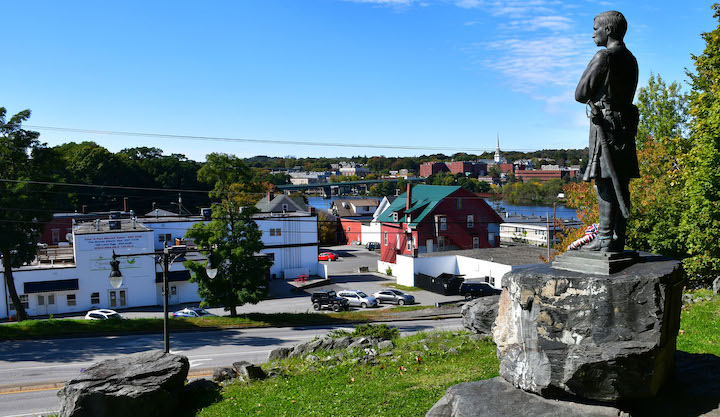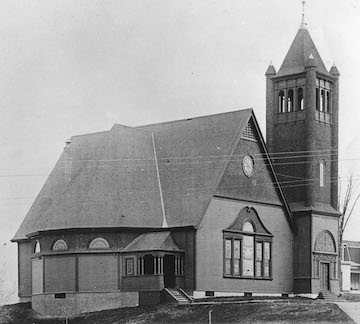Growing up a “Brewer boy” like Joshua L Chamberlain
ECW is pleased to welcome back Brian Swartz, author of the new Emerging Civil War Series bio Passing Through the Fire: Joshua Lawrence Chamberlain in the Civil War
While growing up in Brewer, Maine, I learned in elementary school about Joshua Lawrence Chamberlain, the 20th Maine, and Little Round Top. However, although Chamberlain and I are “Brewer boys” (a local term), I did not realize how much his childhood and adolescent “turf” overlapped mine until researching the biography that became Passing Through the Fire.

According to JLC, his paternal grandfather, Joshua Chamberlain Sr. owned “a homestead” running 440 yards “on the river” and extending “more than a mile and a quarter” inland from atop the “monumental headland” rising steeply above the Penobscot River opposite Bangor.
The future Chamberlain Street (in existence by 1862) ran southeast, probably paralleling the original property. Joshua Chamberlain Jr. (the “Sr.” and “Jr.” vanished historically long ago) built a two-story, wood-framed house and established a farm at modern 80 Chamberlain Street in the 1830s, and Joshua Lawrence Chamberlain and his siblings grew up in this house, a well-maintained private property today.
If the original Chamberlain “homestead” ran southeast 1¼ miles, then the ramshackle farmhouse and barn that my grandparents purchased in the early 1940s stood within or just outside the property’s eastern boundary. The farm was dubbed 272 Chamberlain Street. I grew up next door, and we could not go anywhere without using Chamberlain Street.
We often passed JLC’s childhood home.

The Chamberlains attended the hilltop-perched First Congregational Church. My grandparents introduced me to God there long ago. Never did I imagine that my butt and JLC’s might have occupied the same pew about 120 years apart. We do share the lifetime-lasting religious beliefs instilled in us at First Congo.
Fondly recalling his wintertime activities, JLC remembered “‘sliding down hill,’” especially on the “one royal course on the main street from the Holyoke hill down through the village,” called “downtown Brewer” when I was young. Its south face excavated during late 19th-century railroad construction, Holyoke Hill is still there and is still steep, spanning the railroad cut on a short bridge.
With a “rose-cheeked” girl tucked behind him in “a stout sled,” Chamberlain could still make “a half-mile run” down the hill and into the village today. I never tried it because traffic would kill you in the 1960s. Even in the early 1840s, JLC’s friends stood at intersections “to warn the villagers and travellers [sic]and team-drivers” that the sledders were coming.
Traveling up and down Holyoke Hill many times over the years myself, I never realized that Joshua Chamberlain had sledded this way.
When possible, he and his brothers roamed the woods beyond their parents’ property and occasionally visited “the Indian camps in the deep woods a mile or so beyond the back fields.” Neighborhood children and I played in woods growing in the same area; I doubt any witness tree remained from JLC’s youth, but the forest survives, albeit cleared at its edges by modern development.
A brook crossed Chamberlain Street about 200-300 yards east of No. 80, and the Chamberlain kids played along this brook, well remembered by JLC. Its flow somewhat restricted by surrounding development, the brook bordered a baseball field by the 1960s; I watched games there and noticed the flowing water after heavy rains.
The brook later became a storm sewer.
Chamberlain and I crossed the same Penobscot River into the same Bangor (much larger now than then) and crossed the same Kenduskeag Stream bisecting that city. We both saw from high ground in Brewer or Bangor the eastern horizon-rimming hills he called “the noble crowns of the new-named Wrentham Hills.”
That name did not stick. I’ve always known them as the Dedham Hills, named for a town just across the Hancock County line. But if Joshua L. Chamberlain and I could stand together and chat on Whiting Hill (the highest point in Brewer), we would realize the Dedham Hills had not changed since the 1830s and 1840s.
Over there due east (or so) in Clifton rises “Peaked Mountain,” as JLC knew it; that is the peak’s official name, but we call it “Chick Hill” today. Slightly to the right in Eddington stands the mountain that Chamberlain called “Black Cap,” still the same name.
Learning that Joshua L. Chamberlain and I kicked around the same places in Brewer helped me appreciate the colonel-promoted-brigadier general much more. We share that connection of “place,” and Brewer was and is a special place.
———-
Brian F. Swartz is author of the blog Maine at War.
————-
Source: Joshua Lawrence Chamberlain, “Blessed Boyhood!”: The ‘Early Memoir’ of Joshua Lawrence Chamberlain, annotated by Thomas A. Desjardin and David K. Thomson, (Brunswick, ME, 2013), 1-7, 12, 19-21
4 Responses to Growing up a “Brewer boy” like Joshua L Chamberlain